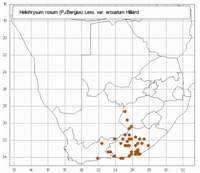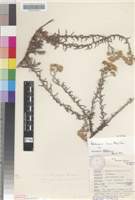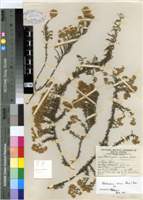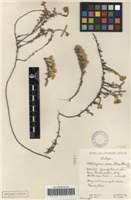Origin of name:
rosum = pinkarcuatus = curved like a bow
Diagnostic characters:
Decumbent spreading stems rooting at the nodesCream-coloured bractsLarge headsOpen branched inflorescence
Description:
Decumbent stems radiating from the stock, these often arcuate and producing short (less than 50 mm), simple, erect flowering shoots at the nodes, sometimes rooting where in contact with the ground. Leaves mostly 8-25 x 1-3 (-5) mm, linear, linear-lanceolate or oblong-lanceolate, apex acute or subacute, base very shortly decurrent, margins revolute or subrevolute, often undulate-dentate, upper surface glabrous to thinly cobwebby-felted, often wrinkled, lower white-felted, the hairs often stringy, or occasionally loosely woolly above and below. Heads heterogamous, oblong-campanulate, c. 4 x 3 mm, few to many in compact corymbose panicles terminating the branchlets. Involucral bracts in 5-6 series, graded, inner about equaling the flowers, imbricate, the bracts being mostly pellucid, the tips of only the inner few series often opaque or semi-opaque and white or whitish, occasionally all pellucid, smooth or rarely slightly crisped, not radiating. Receptacle honeycombed. Flowers 15-28, 4-11 female, 8-21 homogamous. Achenes c. 0.75 mm, broadly cylindric, with myxogenic duplex hairs. Pappus bristles many, about equaling corolla, scabridulous, bases cohering by patent cilia.
Flowering between August and April.
Distribution:
Grows in stony places, sometimes in karroid scrub, or along roadsides. Ranges from about Nelspoort and Murraysburg in the Great Karoo east to Keiskammahoek, south to Addo and NE. to the southern Free State. Sympatric with the typical plant only in the Eastern Cape from about Addo and Grahamstown NE. to Keiskammahoek and NW. to Bedford.
Fynbos, Thicket, Savanna, Grassland and Nama Karoo Biomes.
Notes:
Two varieties are recognized:
(a) var. rosum (b) var. arcuatum Hilliard
Var. arcuatum differs from the typical plant in habit, namely, decumbent stems radiating from the stock, these often arcuate and producing short (less than 50 mm), simple, erect flowering shoots at the nodes, sometimes rooting where in contact with the ground; and in the involucre, the bracts being mostly pellucid, the tips of only the inner few series often opaque or semi-opaque and white or whitish, occasionally all pellucid.
Possibly because of its spreading growth, this is the variety of H. rosum that is most frequently confused with H. dregeanum; see under that species. H. rosum var. arcuatum and H. dregeanum are sympatric mainly in the southern half of the Free State.
Taxonomy:
Literature:
Helichrysum rosum (Berg.) Less. var. arcuatum Hilliard in Flora of southern Africa 33,7 (2): 107 (1983).
Type:
Eastern Cape, Graaff-Reinet distr., 3124 DD, farm Blaauwater, N. of Bethesda Road, c. 5 000 ft., 25 xi 1977, Hilliard & Burtt 10661 (NU, holo.; E; K; PRE; S, iso.).
Synonym(s):
Vouchers:
Hilliard & Burtt 10780 (E; K; M; MO; NU; PRE; S); Hilliard & Burtt 10790 (E; K; M; MO; NU; PRE; S).; Maguire 679 (NBG); Barker 1383 (NBG); Pearson 1329 (SAM); Acocks 9117; Tyson 38 (PRE); Verdoorn 1509 (PRE); Barnard 561 (PRE); Henrici 1826 (PRE); Brueckner 896 (PRE).


